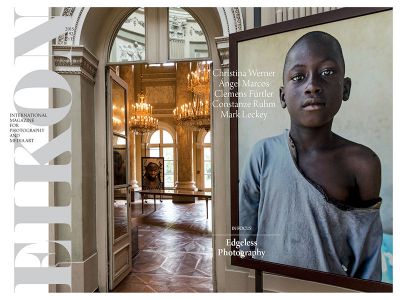
EIKON # 92

Artists | Clemens Fürtler | Mark Leckey | Ángel Marcos | Constanze Ruhm | Christina Werner |
Contributors | Robert Ayers | Thomas Ballhausen | Katharina Brandl | Wolfgang Brückle | Lorenzo Fusi | Matthias Harder | Ruth Horak | Peter Kunitzky | Katharina Manojlović | Margit Mössmer | Ursula Philadelphy | Florian Rainer | Maria Rennhofer | Veronika Rudorfer | Andreas Spiegl | Michael Stoeber | Andrea Winklbauer
Languages | German / English
Dimensions | 280 x 210 mm
ISBN | 978-3-902250-83-4
84 pages
Price: € 14,00 (incl. 10% VAT)
Online Order >>>Content
PORTFOLIO
MARK LECKEY | Andrea Winklbauer
CHRISTINA WERNER | Katharina Brandl
ÁNGEL MARCOS | Maria Rennhofer
CONSTANZE RUHM | Andreas Spiegl
CLEMENS FÜRTLER | Michael Stoeber
ARTS & STUDIES
ASOO KHANMOHAMMADI
IN FOCUS: EDGELESS PHOTOGRAPHY
AT THE PERIPHERY OF THE PHOTOGRAPHIC OBJECT | Lorenzo Fusi
FORUM
BILDING 2007–2014: A Conversation with Gabriele Rothemann | Nela Eggenberger
A LITTLE SECRET FOR THE 100th BIRTHDAY OF ROLAND BARTHES | Ruth Horak
EXHIBITIONS
JOSEPH CORNELL. Wanderlust | Thomas Ballhausen
HUNT'S THREE RING CIRCUS. Amercan Groups Before 1950 | Robert Ayers
GERMAINE KRULL. Photographs | Matthias Harder
Editorial
Since the invention of photography there has been a debate (among others) about the way the camera makes an excerpt. In itself the dimensions of the image in terms of length and width are a quality dictated by technical realities to which, in turn, the entire composition of the image is subordinated. It is not surprising then that the protagonists of art history, for whom such a restriction was still alien, complained that “garrulous photography”, working within the framework it had available to it, reproduced found reality in far too much detail—which was an obstacle, in particular, for the reproduction of artworks, which were customarily spread by means of copper engravings (Moritz Thausing, 1866). In the circle around Henri Cartier-Bresson the image, once excerpted, was then even given an auratic charge so that subsequent cutting of what was already a reduction was scorned and any intervention that altered the original view was treated as photographically amateurish.
Today, with the advancing liberation of photography from its two-dimensional existence with the increasing bundling of the individual branches of art, the (artistic) preoccupation with the margins of the image—and with whatever may be outside it—is taking place on a totally different level: as Lorenzo Fusi points out in the Focus section of this edition on “Edgeless Photography”, the photographic image is concerned especially with drawing attention to what is outside the camera’s visual field, drawing in that space by employing various media or making it at once the main theme of the work of art—this can be taken so far that this space (the outer margin) has become “in a sense, […] more important than photography itself” (Fusi, 57).
Again in the case of the portrait of Henriette Binger, the mother of Roland Barthes, the “stuff around it”—the idea—is more important than the photograph itself. Above all the very fact that the photo, in spite of the importance it has for Camera Lucida, has been kept strictly under lock and key has made it a much-discussed icon. Thanks to the comprehensive research undertaken by Ruth Horak, now, on the occasion of the 100th birthday of Barthes we have the honor to solve one of the little secrets surrounding photography.
We wish you many illuminating moments,
Nela Eggenberger and your EIKON Team



 more
more Editorial
Editorial
